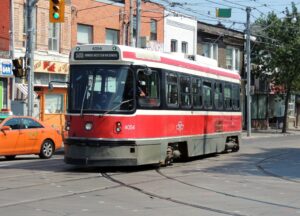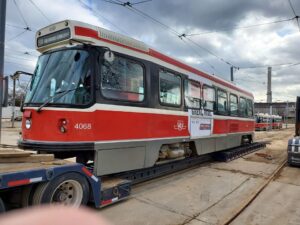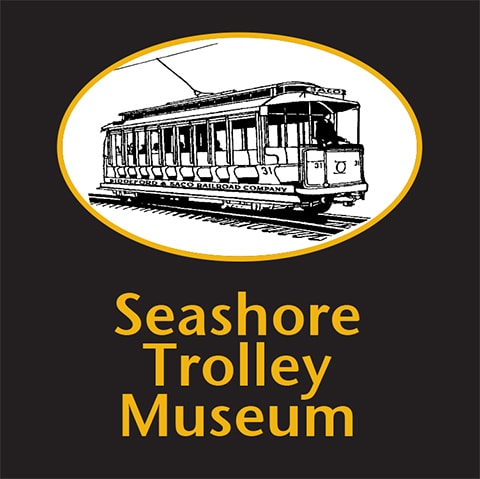
No. 4068 in service in Toronto, July 16, 2013; Michael Doucet photo.
Operating History: Toronto is the only North American city to have retained a significant part of its historic city-wide, traditional streetcar network. By the 1960s, when most U.S. and Canadian cities had abandoned their streetcar systems, Toronto Transit Commission (TTC) became the largest remaining streetcar operator in North America. The Toronto system uses an unusual 4’ 10 7/8” track gauge. In the 1970s, a large fleet of PCC streetcars served the city and which were approaching the end of their economic life. In 1973, the province of Ontario formed the Urban Transportation Development Corporation (UTDC) to develop new streetcars for TTC and for possible sale to other transit operators. After a worldwide evaluation of light rail technology, UTDC designed the state-of-the-art Canadian Light Rail Vehicle (CLRV). The CLRV was a sophisticated car with an on-board computer, spin-slide control and energy-saving chopper control. The TTC agreed to acquire a fleet of 200 (later reduced to 196) CLRVs. UTDC contracted with Swiss Industrial Company to build six test vehicles (Nos. 4000 – 4005) which were tested in Austria and Switzerland before delivery to Toronto in 1977-78. Hawker Siddeley Canada built the remaining 190 CLRVs (Nos. 4010 – 4199) at its former Canadian Car & Foundry plant in Thunder Bay, Ontario. Hawker Siddeley delivered the cars between 1979 and 1981. The UTDC failed to find other buyers for its CLRVs.
The TTC used the CLRVs on all its lines. The cars came with a new, bright red, black and white paint scheme. Passengers appreciated the smooth ride, bright fluorescent lighting and large windows, although the cars were not air conditioned (except for No. 4041). In the late 1980s, 52 Articulated Light Rail Vehicles (ALRVs) were added to the fleet, eventually resulting in the end of PCC car operation. The ALRVs shared much of the CLRVs industrial design. After a long service life, TTC began replacing the CLRVs with 204 accessible, low floor, articulated “Flexity” cars from Bombardier in 2014. By the end of 2019, TTC had received enough new cars to retire the last of the CLRVs.
Museum Ownership: In early 2020, the TTC donated Nos. 4068 and 4133 to Seashore. The TTC also donated several other CLRVs to other museums. At Seashore, the CLRVs will join Toronto “Peter Witt” streetcar No. 2890, built in 1923. The Toronto cars are part of the museum’s extensive collection of Canadian transit vehicles – the largest outside of Canada. The CLRVs became the newest rail vehicles in the Seashore collection. Seashore acquired No. 4133 for the purpose of using its trucks to be converted to standard gauge and be placed under No. 4068. Seashore moved the two CLRVs to the Halton County Radial Railway (Ontario Electric Railway Historical Association) in Milton, Ontario for storage pending re-gauging work. Seashore sent the trucks from No. 4133 to the Illinois Railway Museum in Union, IL where a contractor is expected to re-gauge the trucks. Then, Seashore plans to put the wide-gauge trucks from No. 4068 under No. 4133. After Seashore brings both cars to Kennebunkport, No. 4133 will be a stationary party car or inside space in the children’s area near the site of the former library building.
Current Condition: No. 4068 was in operating condition when it left Toronto. As of September 2021, Nos. 4068 and 4133 are at the Halton County Radial Railway awaiting the re-gauging.

No. 4068 loading onto truck to be stored at Halton County Radial Railway, until Seashore arranges for truck regauging; Douglas Carrier photo.
 |
 |
 |
